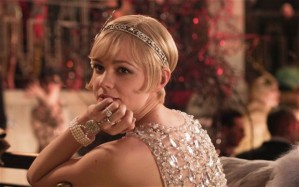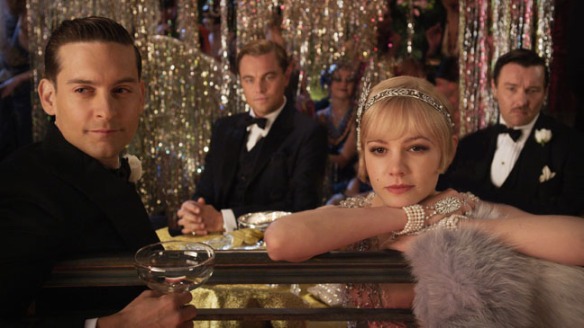“You want to see an auteur?” Baz Luhrmann’s newest film seems to scream. “I’ll show you an auteur!” This new rendition of The Great Gatsby is all but bursting at the seams with Luhrmann’s characteristic quirks — explosions of glitter, anachronisms, forbidden love, outrageous parties, and a slow tragedy unwinding on a typewriter. It is almost a caricature. Fans of Luhrmann’s Moulin Rouge! and Romeo + Juliet will not be disappointed.
Adapted from the 1925 novel by F. Scott Fitzgerald, the film features Nick Carraway (Tobey Maguire), a young bond salesman who rents a summer cottage in Long Island next to the sumptuous mansion of the mysterious Jay Gatsby (Leonardo DiCaprio). When Carraway is invited to one of Gatsby’s lavish parties, the two become friends and Carraway agrees to help Gatsby in his pursuit of an old flame: Carraway’s own cousin, Daisy Buchanon (Carrie Mulligan), who lives with her husband Tom (Joel Edgerton) across the bay.
The story is framed by Carraway’s narration years later, during his stay in a sanitarium for treatment of his depression and alcoholism. His doctor encourages him to write his memories down as a therapeutic exercise, and it is through these writings that we experience Gatsby’s story. It’s an unnecessary and somewhat clichéd framing device, as Carraway’s voiceover would easily carry the scenes on its own, but the writing aspect does allow Carraway to wax poetic in his narration. His lines are slow, lyrical, and lovely, often quoting Fitzgerald’s original text directly, and this allows the film to stay remarkably true to the novel — an appropriate choice for an adaptation with such a unique and different aesthetic.
Because the aesthetic is truly powerful. The colors are oversaturated, the camerawork feverish, the costumes sparkling. It is gorgeous, dazzling, and at times a little jumbled. Notably, Gatsby’s parties roar with contemporary music, flappers dancing to Lana Del Rey, Kanye West, Jay-Z, Fergie, and Beyonce. This is perhaps an attempt to draw a link between the “roaring 20s” and our own era — hip-hop serving as the contemporary equivalent to jazz of the 20s — but if so, the message isn’t entirely clear. The Great Gatsby is completely wrapped up in the era in which it takes place, and thus it is a difficult story to modernize, to separate from the 1920s. Ultimately, the anachronistic soundtrack comes across as a fun quirk more than anything else.
The characters, on the other hand, are wonderfully sketched. Luhrmann and Craig Pearce’s screenplay teases out the characters’ nuances, revealing their kindness and charisma as well as their tragedy. Gatsby is handsome and coiffed, composed and constantly repeating the jovial catchphrase “old sport.” His self-assurance is tenuous, however, and DiCaprio does a fine job of conveying Gatsby’s nervous energy and, at times, apparent unease. “The way he spoke — no wonder people thought he was lying,” Carraway notices.
 From across the bay Gatsby can see a green light pulsing at the end of Daisy’s dock, and he obsesses over it, formulating a detailed plan for how he’ll win her back and reshape his own life. Daisy in particular, a character usually accused of being vacuous, is given new resonance in the film, exhibiting a jadedness behind her flirty, flighty façade. She tells Carraway that when her daughter was born, she said to the doctors, “I hope she’ll be a fool. That’s the best thing a girl can be in this world: a beautiful little fool” — and it seems that throughout the film, Daisy actively chooses to play the part of the fool. On the day she and Gatsby are finally reunited, he tosses all of his beautiful shirts onto the bed where she sits, and she bursts into tears. “It just makes me sad,” she says. Carraway’s narration supplements (in a line that is not in the original book), “Five lost years struggled on Daisy’s lips, but all she could manage was…” “I’ve never seen such beautiful shirts,” Daisy says. For some reason she withholds emotionally, instead commenting on his evident wealth.
From across the bay Gatsby can see a green light pulsing at the end of Daisy’s dock, and he obsesses over it, formulating a detailed plan for how he’ll win her back and reshape his own life. Daisy in particular, a character usually accused of being vacuous, is given new resonance in the film, exhibiting a jadedness behind her flirty, flighty façade. She tells Carraway that when her daughter was born, she said to the doctors, “I hope she’ll be a fool. That’s the best thing a girl can be in this world: a beautiful little fool” — and it seems that throughout the film, Daisy actively chooses to play the part of the fool. On the day she and Gatsby are finally reunited, he tosses all of his beautiful shirts onto the bed where she sits, and she bursts into tears. “It just makes me sad,” she says. Carraway’s narration supplements (in a line that is not in the original book), “Five lost years struggled on Daisy’s lips, but all she could manage was…” “I’ve never seen such beautiful shirts,” Daisy says. For some reason she withholds emotionally, instead commenting on his evident wealth.
Tom is inveterately unfaithful to Daisy, and Gatsby’s love for her is fueled primarily by his own desire to recapture the past. (Significantly, the love scenes between Gatsby and Daisy are cut with Lana Del Rey’s poignant crooning, “Will you still love me when I’m no longer young and beautiful?”) For both men she is a prop, an accessory. In the climactic scene in the hotel when he and Tom fight over possession of her, they are all but feeding her lines, informing her of her own feelings. In the end, what Carraway sees as Daisy’s selfish recklessness is perhaps simply a decision to give in — a surrender in the hopeless battle for control over her own life.
DiCaprio and Mulligan carry the film, but the supporting cast is also strong. A particularly masterful performance comes from Edgerton as Tom, the brutish polo player, brazenly discussing white supremacy and taking calls from his mistress during dinner. Cruelly masculine, Tom also has moments of surprising vulnerability and tenderness when faced with the loss of his wife and his mistress. Maguire is an apt Carraway — perhaps a little goofy, but appropriately naïve, enamored of Gatsby and happy to be taken along for the ride. He tends to blend into the background, drowned out by the “kaleidoscopic carnival” that is Gatsby’s world.
The tale that Luhrmann tells us here is more dramatically tragic than Fitzgerald’s original novel; the colors are brighter; pacing is faster. Is this the pained, understated Gatsby you read in high school? Maybe not. But once you clear away all the sparkles and spectacle — the Baz-Luhrmann-ness of it — the heart of the story is there, pulsing as steadily as the green light at the end of Daisy’s dock. This may never be considered the essential film adaptation of Fitzgerald’s novel, but it is a fun, beautiful, and true adaptation. In an interview with Tribute Entertainment, Luhrmann says of Gatsby, “If it’s a great work, it’s there to be done many times in many different ways.” I can get behind that.

